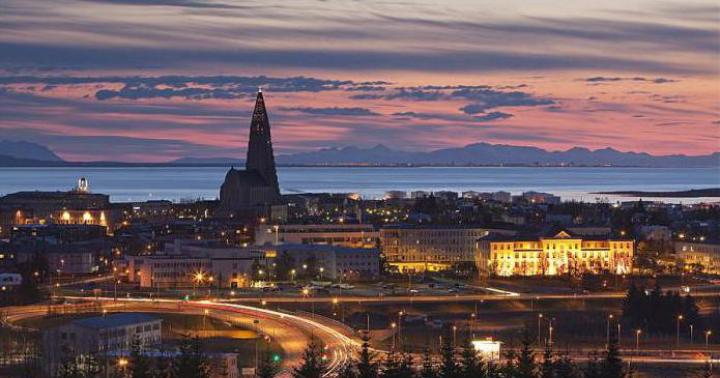A mountain range in Portugal, part of the Central Cordillera mountain system, located in the Guarda (mostly) and Castelo Branco districts. The highest point of the ridge, Mount Torre (1993 meters), is the most high peak continental Portugal and the second highest in the entire country, second only to Ponta do Pico on the island of Pico in the Azores. There is a monument at the top of Torre.
The landscapes of Serra da Estrela were formed during the last glaciation, when the retreating glacier left horseshoe-shaped valleys, flattened landforms, and glacial lakes... The vegetation of the park is distributed according to the altitudinal zonation and is located in three zones. Below 900m there are broad-leaved forests, between 900 and 1600m - coniferous forests, and above 1600m - only meadows, which are a forage base for local sheep species. Many rivers originate in the Serra da Estrela mountains, including the Mondego, the largest river whose bed is entirely in Portugal. Part of the Serra da Estrela is part of the eponymous natural park... The park is home to the only one in Portugal ski resort.
Pre-Christian ancient legends tell that the Estrela mountains were created by the gods from huge stones and folded so that it would be convenient for the shepherds to graze their sheep, and for the gods to descend here to earth from their stars. Hence the name of the mountains - Estrela, which means star.
Archaeological research has restored a way of life local residents in the 5th millennium BC in the Neolithic era, the main activities of which were hunting, gathering and sheep breeding. “Shepherds” in the warm months grazed their herds in the high-mountain pastures, and in the winter they descended into the river valleys. The importance of the Serra da Estrela mountain range in the Neolithic culture of the Beira region is demonstrated by the megalithic monuments of the Mondego river valley. This is especially noticeable in Carregal do Sal (Carregal do Sal). The ancient Dolmens of this region are oriented towards the peaks of the Serra da Estrela. In the place where the brightest star of the constellation Taurus, Aldebaran, rises in the warm season. Its appearance in the sky in April-May meant a transition to summer, which means a return to high-mountain pastures. Ancient Greek geographers called these mountains “the mountains of Hermes”, the god of trade, who was also the patron saint of shepherds. It was this region that became the birthplace of the famous Lusitanian warrior Viriato, who opposed Roman rule.
There are traces of earlier cultures, for example, the ancient necropolis of São Gens (Necrópole de São Gens). The Roman period is marked by sites such as the Sanctum Sellas near Belmonte and the remains of the Roman road that connected Merida and Braga (Roman bridge). Arab domination can be traced in the irrigation system.


Modern villages and towns located in the mountains are located in the valleys and were founded in the Middle Ages. The most famous of them are the historic villages of Linhares, Belmonte and Piodan, as well as the highest village in Portugal, Sabugueiro, the village of Manteigas, located in the heart of the mountains in the valley of the same name, and the town of Celorico da Beira. It is also interesting to visit the towns of Guarda, Covilha and Seia.
The main economic sector here is agriculture, mainly grazing (goats and sheep). Traditional crafts such as basket weaving, weaving and embroidery are also developed. The main pride of the region is the shepherd dog breed -.
5 most interesting sights of Serra da Estrela
- Top of Mount Torre the most high mountain continental Portugal - 1993 meters. Snow falls here in winter and there is a ski slope near the top.

2. Penedo da Sino rock in the Serra da Estrela mountains is located in the necropolis of the abandoned village of São Gens near the village of Forno Telheiro, which is one of the largest and oldest in the area. The old village was abandoned in the 10th century and nothing remained of the old buildings. At this place, a settlement has existed since the Neolithic era.
Photo by Vitor Oliveira

3. Valley Vale do Rossim in the Serra da Estrela mountains covered with snow in winter! The valley is located at an altitude of 1300 meters near the town of Manteigash. Now most the valley is occupied by a reservoir formed after the construction of the dam in 1956. Reservoir beach made it to the final of the 7 national competition best beaches Portugal! It's hard to believe in winter.
Photo by Nuno Trindade

4. The famous sculpture Senhora da Boa Estrela is located near the highest point of continental Portugal, Mount Torre in the town of Covão do Boi. This 7-meter image of the Virgin Mary was carved into the rock in 1946 by the artist António Duarte, and according to legend, it guards all the shepherds of the Serra da Estrela mountains. It is especially beautiful here in winter, when pure white snow falls on the black rocks.

5. River beach in the village of Luriga (Loriga), which is called “Portuguese Switzerland”. Several small ponds descend in terraces along the mountain stream to the old Roman bridge.

Serra da Estrela
Serra da Estrela
(Serra da estrella), a mountain range to the west. Iberian Peninsula , continuation of the mountains Centre. Cordillera ... Highest in Portugal (Estrela, 1991 m). Length approx. 80 km, width up to 25 km. The peaks are rocky, with sharp jagged ridges (serra - literally "saw"). Deep river valleys with steep slopes. It is composed of granites, gneisses, and quartzites. Mining of tungsten and tin ores. Mild summers, mild winters, precipitation approx. 2500 mm per year. Up to 1500 m areas of pine, oak, chestnut forests. Above are shrubs, alpine meadows. Sheep.
Dictionary of modern geographical names... - Yekaterinburg: U-Factoria. Under the general editorship of Acad. V. M. Kotlyakova. 2006 .
See what Serra da Estrela is in other dictionaries:
- (Serra dа Estrella) the highest (up to 1991 m) mountain range in Portugal. Mediterranean shrubs, forests, meadows. Deposits of tungsten ores, tin. Natural Park … Big Encyclopedic Dictionary
- (Serra da Estrella), the highest (up to 1991 m) mountain range in Portugal. Mediterranean shrubs, forests, meadows. Deposits of tungsten ores, tin. Natural Park. * * * SERRA DA ESTRELA SERRA DA ESTRELA (Serra dа Estrella), the highest ... ... encyclopedic Dictionary
- (Serra da Estrella) mountain range in central Portugal. Length 80 km, height up to 1991 m (Estrela). It represents the uplifted western outskirts of Meseta (See Meseta). The peaks have smooth outlines; the slopes are steep, strongly ... ... Great Soviet Encyclopedia
- ... Wikipedia
Serra da Estrela: Serra da Estrela (sub-region) is an economic statistical sub-region in central Portugal. Serra da Estrela (mountain range) mountain range in Portugal. Serra da Estrela ( natural Park) natural park, ... ... Wikipedia
This term has other meanings, see Serra da Estrela (disambiguation). Serra da Estrela Serra da Estrela ... Wikipedia
This term has other meanings, see Serra da Estrela (disambiguation). Serra da Estrela port. Parque Natural da Serra da Estrela ... Wikipedia
Portugal is not only languid and relaxed Porto and Lisbon with burnt-out red roofs, not only surfing and secluded beaches. Alina Adaeva, photographer, guide-instructor and creator of travel games, tells about the mountains of Portugal, which you should definitely include in your itinerary.
The Serra da Estrela mountains are located in the national park of the same name in the north-east of Portugal. The highest mountain in the mainland of Portugal - Torre, with a height of only 1993 meters, pastures, fields and vineyards, the only ski resort in the country with natural and artificial snow, the largest rivers Zeseri and Mondego and the network hiking trails - all this will welcome you with open arms in the Estrela mountains. Feel free to include this place in your itinerary in Portugal and do not forget to take a sweatshirt - it is much colder in the mountains than off the coast, especially at night.
How to get there?
The Serra da Estrea Natural Park is 300 km away and 190 km away. Nearest major settlements to your destination - Guarda and Coviglian. The final destination is the village of Manteigash, from where it is most convenient to start any movement in the natural park. And it would not hurt to grab a card at the tourist office.
Of course, the ideal option is to get there. Still, you can't get right into the heart of the nature park by bus. If with your vehicle very tight, then you should not be sad for a long time. From Lisbon to Guarda or Covigliana there are both trains (3 times a day for € 18) and buses (5 times a day for € 15). From these towns to Manteigash, either grab a taxi or use the good old hitchhiking.


Where to stay?
When you finally get to Manteigash, you will understand why it was worth going at least for his sake. The village lies in mountain valley, all of his houses are painted white and the roofs are bright orange. It looks magical, especially when viewed from any observation deck (from any higher street) and at dawn.
Finding an overnight stay in Manteigash will not be a problem for you. There are a lot of options on your favorite Booking. Casa Das Obras is a good option. This is a manor house with a history of 250 years, where all rooms are works of art. The price is incomparably small compared to the comfort and view that is offered.
Things to do?
When you settle in Manteigash, do not sit for a long time with a glass of wine at the window, but put on the most comfortable shoes and go to the tourist office. It is located in the very center of the town on the main road and stop - you won't get lost. There, take a map of all the walking routes in the park, ask the employees about each and choose the color and taste of your choice. And don't even try to go around everything at once: all 375 kilometers of hiking trails are hardly within your reach.
The routes are very varied. Starting from light a couple of kilometers and ending with long 2-3 days. The landscape and vegetation on each of them change every half hour: just have time to follow and photograph.
Do not lose sight of Mount Torre. A road leads to its top, so you will put a tick in your personal list of conquered peaks without much effort.









Serra de Estrela is a natural park that contains the highest mountain range in Portugal. This place is one of the most outstanding natural attractions in the country.
Hikers come here all year round, and in winter skiers visit Penhas da Saúde and Torre. The views around Torre Resort are truly fabulous. Particularly delightful are the landscapes of the Zêzere Valley, home to the deepest U-shaped gorge in Europe.
By the way. On the slopes of the Serra de Estrela goats graze, from whose milk they make cheese, which is famous throughout the country.
In the vicinity of the park there are interesting villages located on the slopes of the mountains. In Linhares, you can feel yourself in the Middle Ages by visiting the local castle and strolling along the narrow cobbled streets. The local church houses three icons by the famous Portuguese artist Grão Vasco.
In the southwest of the park is the most picturesque village in Portugal - Piodao. The houses here are made of slate, decorated with white doors and windows, which contrasts surprisingly with the dark stone.
There are several routes for tourists in the park. Most Popular:
- Ancient Jewish route. It was in the vicinity of Serra de Estrela that Portuguese Jews were hiding from exile. Now you can visit the places where secret communities were organized.
- Route through ancient villages. This route will visit the most picturesque villages in the region.
- The Wool Route. During this route, tourists visit the wool museum and factories of the region. In some places, craftsmen still make woolen products by hand.
How to get to Serra de Estrela
The park is located in the center of the country, 300 km from and 200 km from. Nearest bus station called Seia. Buses leave here from Lisbon twice a week from Oriente Station. The journey lasts 7 hours. You will have to take a taxi from the station. The trip will take about half an hour and cost approximately 20 €.
If you have the opportunity to ride these mountains, do not skimp on time and take the most winding road. It is easy to find it on the map: it winds like a snake along the slopes of the mountains, creates unthinkable turns, but fantastic beauties also open up.
Serra da Estrela is the land of the former dominion of glaciers, which, descending the heaving slopes, left a quaint landscape behind them. Sometimes the mountains seem to be strewn with small and large stones, sometimes smooth boulders the size of a house come across. It looks as if the giant scattered boulders, but did not dare to collect it.
Especially in the Serra da Estrela in the spring. In clear weather, you can see far, far away, and the ground below seems ghostly.
The glaciers left behind not only bizarre stone scatters, but also lakes. They lie in the arms of the rocks and from a distance seem unrealistically blue, as if a piece had fallen off the sky and now rests peacefully on the ground, without asking back.
Water is no less beautiful in artificial formations - like this lake behind a formidable dam. You can walk along it and look down, and behind its wall water splashes.
Not far away, the Madonna is looking out of the rocks, guarding the difficult path through the mountains.
Serra da Estrela is far from deserted. Apart from tourists and skiers who visit the local resort when a miracle happens and snow falls (and this does not happen every year - it's still warm and not high), there are many villages, and some of them are very ancient. Whoever was there: both the Arabs and the Romans, and the Portuguese themselves know where the place is better.
Locals find something to do with themselves: they grow grapes, from which they then make excellent wine ...
... graze sheep (by the way, local shepherd dogs are very smart and devoted creatures, and a rather famous cheese is made from goat's milk) ...
And they treat tourists who have looked at the light with all sorts of tasty things, for example, lamb chop, fresh and soft, or a cream of a suspicious-looking, but wonderful taste.
Mount Torre, the highest point of the Serra da Estrela, is a very meditative place. The domes that provide it with a two thousand meter status are similar to the old observatories. It is quite possible that they are.
The mountains lie around in a haze and seem to be painted on a pale hot sky.
By the way, the roads in Serra da Estrela are good. The main paved tracks are smooth, with excellent markings, so they are safe to ride even in the evening.
But if you decide to take a risk and deviate from the intended path, then difficulties may await you. Make sure you understand where you are going: some mountain paths are unsafe. Somewhere they walk along the edge of an abyss, somewhere they are so narrow that it is impossible to disperse on them, and everything else they are in bumps, so that you are shaken from side to side. The adventure is not for the faint of heart. Although in appearance such a bumpy road may look peaceful, for example like this. But try to ride it!
But the impudent will be rewarded with a "" contact with the real wild nature Serra da Estrela. Small calm lakes are suddenly found on the plateau ...
Sometimes you come across abandoned buildings, on which, nevertheless, the tiles are bright red.
In some places - very rarely, because this is not quite her fiefdom, but lavender still blooms.
And then there is such a miracle - waterfalls.
This one, the long one, is called the Devil's Mouth. There are signs on it, but not all of them can be trusted: some of them lead away not by tourist paths, but by treacherous mountain paths. And yet the result is worth it. The waterfall is noisy, beautiful and surrounded by picturesque rocks.
And on the main roads there are often waterfalls just falling from the mountains, prudently fenced off so that drivers are not disturbed.
Having traveled, you can sit on the terrace of a small roadside restaurant, order a cup of strong local coffee ...
And watch the setting sun gently touch the mountain peaks.
















